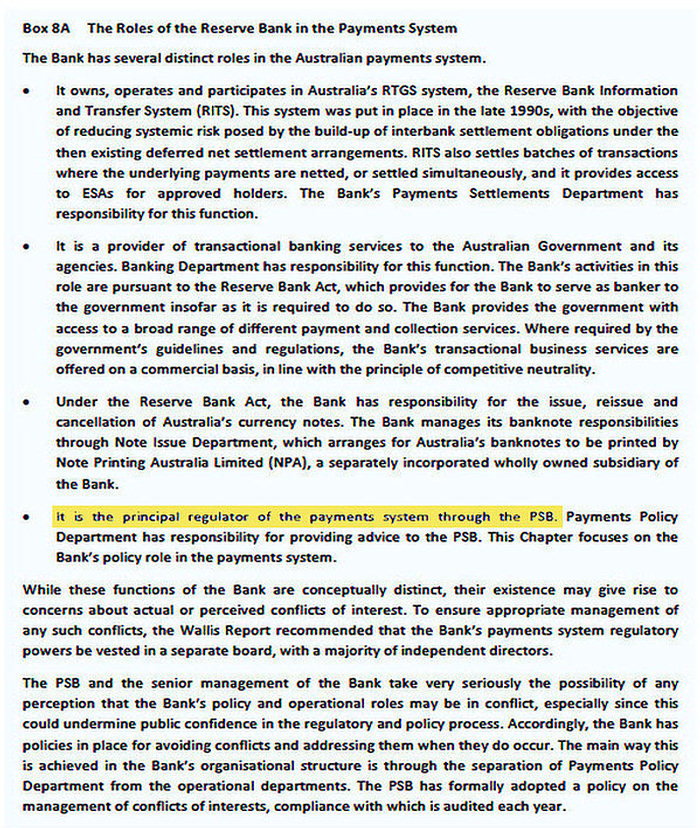|
| |
Grounds/Reasons for
the Written Questions
Chapter 9. There are over 100 voluminous
'Submissions', 'Reviews', 'Reports', 'Discussion Papers', 'Staff Working Papers'
and 'Enquiries'
in Australia in the last 10 years on Credit Cards. None
have identified the 'Fundamental Information', namely the percentage and
aggregate that
Interest and Penalty Fees
contribution to aggregate Card Issuers' annual revenue.
Credit Card Issuers
and
Credit Card Networks on
the
Wholesale Supply Side have done a masterful job in concealing the overwhelming
returns from
Interest and Penalty Fees
and which
Financial Literacy Demographic Quintiles
of Credit Cardholders are paying it
The Reserve Bank can require Australian banks to provide any financial data to
the Reserve Bank that
it wants to appraise - "any financial data"
Reserve
Bank has failed to draw upon its
Extensive
Powers
and Responsibilities to (All) Australians
to require major
Credit
Card Issuers (Four Pillars ) to provide financial information for
Credit Card Products
that identify cohort/s of
Credit Cardholders
that have paid an excessive burden of
Interest And Late Payments Fees (Chapter
9 and
Question 9), even after the
Reserve
Bank identified the material
Outstanding Indebtedness
carried by
Persistent Revolvers
(in Aug 2015),
whilst
67% circa
of
Credit Cardholders
Transactors
enjoy
a
Free Ride
with their
Revolving Lines of Credit
The
Four Pillars enjoy 80%
of the
Credit Card Market.
The below 'repeat' of the further above extract from
5. IMPACT ANALYSIS
of
RBA 2002
evidences that the
Scheme Providers,
as are the other parties under the
Wholesale Supply Side,
are masterly at concealing fundamental empirical evidence of the break-up of
aggregate Credit Card Revenues. Notwithstanding that there have been over
100 voluminous
'Submissions', 'Reviews', 'Reports', 'Discussion Papers', 'Staff Working Papers'
and 'Enquiries'
on Credit Cards by RBA, ABA, banks,
Credit Card Networks,
Senate Committees, regulators, Treasury,
Australian Retailers Association 'et al' in the last 10 years.
The Reserve Bank's
Submission
to the Financial System Inquiry - March 2014
noted:
"In 1998, the government
implemented a range of reforms that were generally in line with the broad
structure and powers recommended by the Wallis Committee. The responsibility for
oversight of the payments system was entrusted to the PSB. The PSB’s
responsibilities and powers are set out under four key pieces of legislation:
*
Reserve Bank Act 1959,
*
Payment Systems (Regulation) Act 1998 (the PSRA),
*
the Payment Systems and Netting Act 1998
(the PSNA), and
*
Part 7.3 of the Corporations Act."
"The
Reserve Bank’s policy-making role is one of the four different roles of the Bank in the
payments system (see ‘Box 8A: The Roles of the Reserve Bank in the Payments
System’).
The Reserve Bank is the principal
regulator of the payments system through the PSB. Payments Policy
Department has responsibility for providing advice to the PSB."
"The
Payment Systems (Regulation) Act 1998 gives the Reserve Bank of Australia
'extensive powers' to gather information from a
payment system or from individual participants."
"The Payments
System Board was established by the Commonwealth
Govt. in 1998 so as to best contribute to:
.......... and
promoting competition in the market for payment
services."

As elaborated in Chapter 15 below,
Section
10(2) of the
Payment Systems (Regulation) Act 1998
says:
‘It is the duty of the
Reserve Bank Board, within the limits of its
powers, to ensure that the monetary and banking
policy of the Bank
is
directed to the greatest advantage of the people
of Australia and that the powers of the Bank ...
are exercised in such a manner as, in the
opinion of the Reserve Bank Board, will best
contribute to
...........the
economic prosperity and welfare of the
people of Australia.
The Reserve Bank can
exercise its
"...extensive powers"
under the
Payment Systems (Regulation) Act 1998
to
"gather
information from payment system participants and operators"
by requesting each of the
Four Pillars
to provide (to the Reserve Bank) financial information of their combined
Credit Card Products for the
financial year ended 30 June 2016 which enables the Reserve Bank to present to the
Australian Parliament the -
(i) same
style 'pie charts' for "Card Issuers'
Revenue" [that quantifies at least seven revenue sources] and "Card Issuers'
Costs" [that quantifies at least five costs, which include
Rewards Programs] that is displayed in
Chapter 8;
(ii) same style
"annual
Report to the
Congress on the Profitability of Credit Card Operations of Depository
Institutions (displayed in
Chapter 8) that the
Board of
Governors of the U.S. Federal
Reserve provided to the US Congress for annual financial accounts as at June 2016;
(iii) annual
cost of
Rewards Programme
and the contribution to this annual cost from
Interchange Fees; and
(iv) aggregate and the percentage of
gross interest revenue
that is paid by the highest paying 20% of
Interest
paying
Credit Cardholders
to assist appraisal of the application of the
User Pays Principle
for
Credit Cardholders
that
hold
over
16 million Credit Cards
in Australia.
=====================================================================================
Refer:
| |
|
